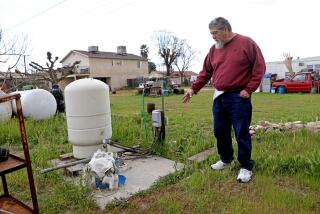Drought Hits North Hardest; Southland Has Few Problems
- Share via
SAN FRANCISCO — Utilities with drought-caused water shortages have tripled in number to 77 since July, but most are in Northern California and the Southland is “experiencing few difficulties,” according to the latest statewide drought survey.
Meanwhile, state water officials are starting to prepare for the worst--an “unprecedented” third year of drought next year that could reintroduce Californians to water rationing.
The hardest-hit agencies all are in the remote Northern Sierra and Southern Cascade counties of Lassen, Plumas, Siskiyou, Sierra and Modoc in northeastern California. Also facing a serious shortage is the town of Trinidad on Humboldt County’s coast about 65 miles south of the Oregon border.
43 of 58 Counties Affected
Only 15 of the state’s 58 counties are without at least one drought-starved water company. In Southern California, the Los Angeles Department of Water & Power reports the least severe shortage, as do the Anza Mutual Water Co. in Riverside County and the Yucaipa Valley, Hi-Desert and Big Horn Mountains districts in San Bernardino County.
The city of Ventura has the most severe problem in Southern California, having lost more than 25% of its supply, which, according to the report, it makes up by taking more water than it should from Lake Casitas.
Not all the news is bad, however. Two San Joaquin Valley water districts that reported severe shortages in the last statewide survey two months ago have since received 50,000 acre-feet each from the U.S. Bureau of Reclamation’s New Melones Reservoir.
First Since 16th Century
An acre-foot is a standard volumetric measurement of 325,851 gallons, which water officials say is enough to satisfy the water needs of two urban families for one year, or irrigate a quarter-acre of alfalfa.
California has not had a three-year drought since the 16th Century, but the state’s water planners nonetheless are working alongside federal, regional and local officials to develop contingencies should 1989 deliver less-than-average precipitation.
Among the options being considered are voluntary conservation and mandatory rationing, diverting supplies from farms and overpumping wells, relaxing water standards and building new facilities in the Sacramento-San Joaquin Delta east of San Francisco.
More to Read
Sign up for Essential California
The most important California stories and recommendations in your inbox every morning.
You may occasionally receive promotional content from the Los Angeles Times.










